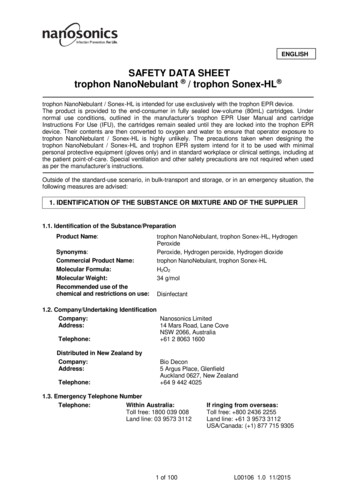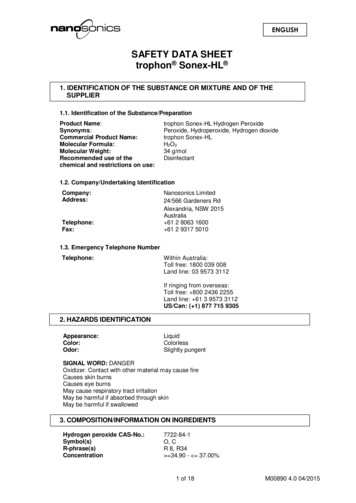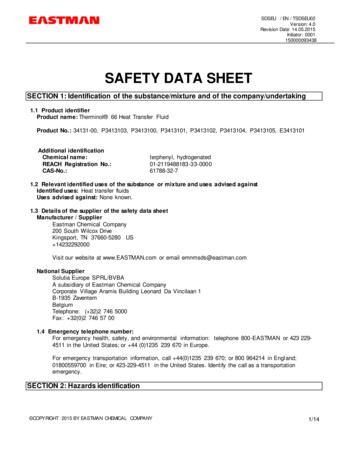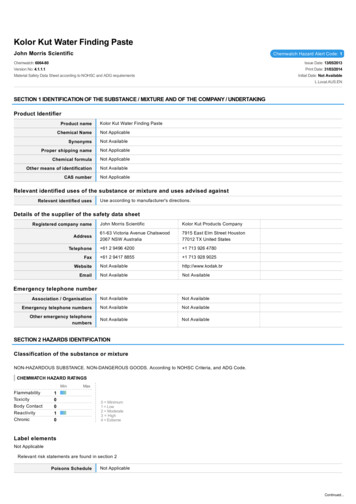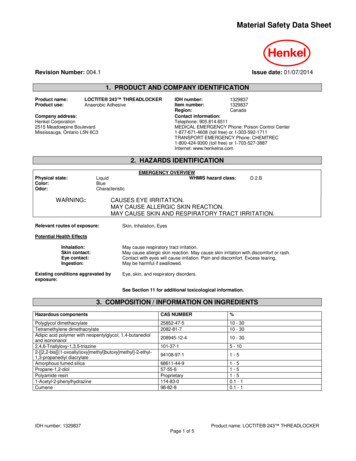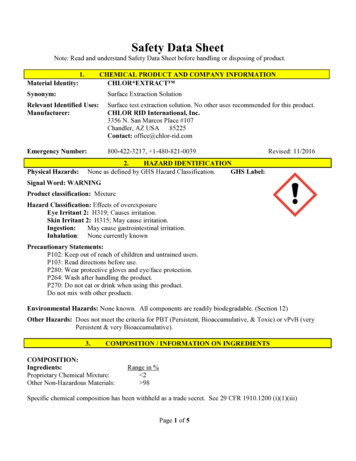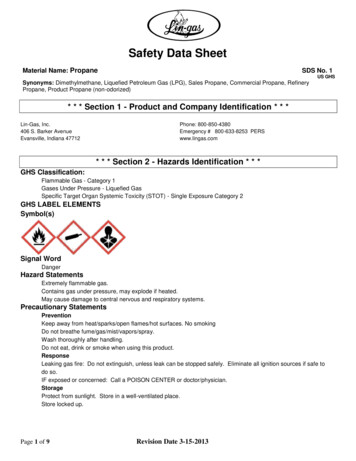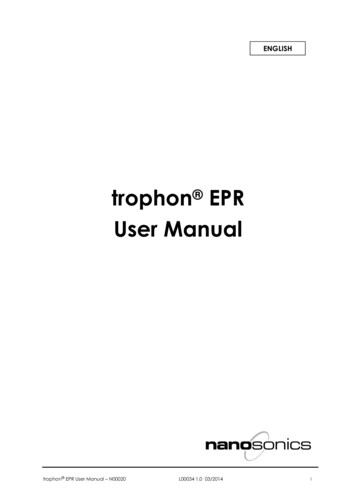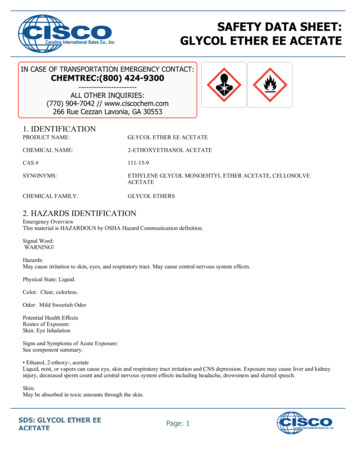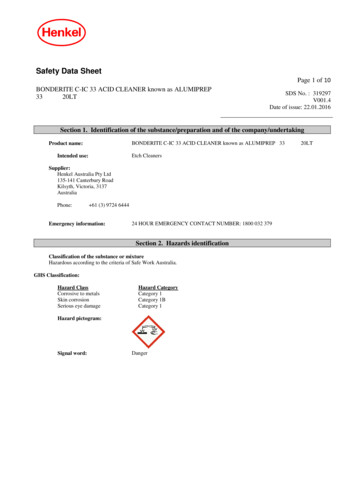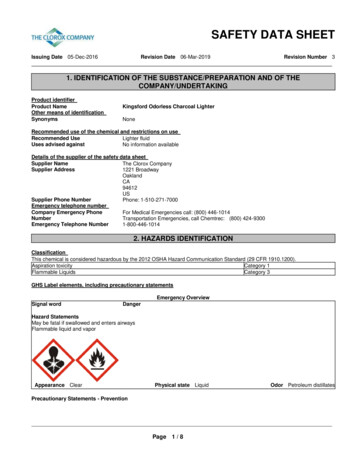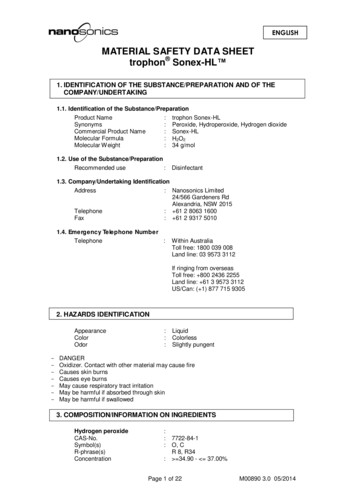
Transcription
ENGLISHMATERIAL SAFETY DATA SHEETtrophon Sonex-HL 1. IDENTIFICATION OF THE SUBSTANCE/PREPARATION AND OF THECOMPANY/UNDERTAKING1.1. Identification of the Substance/PreparationProduct Name: trophon Sonex-HLSynonyms: Peroxide, Hydroperoxide, Hydrogen dioxideCommercial Product Name: Sonex-HLMolecular Formula: H2O2Molecular W eight: 34 g/mol1.2. Use of the Substance/PreparationRecommended use:Disinfectant1.3. Company/Undertaking IdentificationAddress: Nanosonics Limited24/566 Gardeners RdAlexandria, NSW 2015Telephone: 61 2 8063 1600Fax: 61 2 9317 50101.4. Emergency Telephone NumberTelephone:Within AustraliaToll free: 1800 039 008Land line: 03 9573 3112If ringing from overseasToll free: 800 2436 2255Land line: 61 3 9573 3112US/Can: ( 1) 877 715 93052. HAZARDS ssSlightly pungentDANGEROxidizer. Contact with other material may cause fireCauses skin burnsCauses eye burnsMay cause respiratory tract irritationMay be harmful if absorbed through skinMay be harmful if swallowed3. COMPOSITION/INFORMATION ON INGREDIENTSHydrogen ::7722-84-1O, CR 8, R34 34.90 - 37.00%Page 1 of 22M00890 3.0 05/2014
4. FIRST AID MEASURES4.1. Inhalation- Remove person to fresh air.- Consult a physician if irritation occurs and persists.4.2. Eye Contact- Rinse immediately with plenty of water, also under the eyelids, for at least 15minutes.- Get medical attention immediately4.3. Skin Contact- Remove contaminated clothing.- Wash with soap and copious amount of water.- Consult a physician if irritation occurs and persists.4.4. Ingestion- Call a poison control center or physician immediately. Do NOT induce vomiting unlessdirected by a physician- If Conscious: Rinse mouth thoroughly with water.- If Unconscious: Never give anything by mouth to an unconscious person.5. FIRE FIGHTING MEASURES5.1. Suitable extinguishing media- Flood with water.5.2. Fire / Explosion Hazards- Product is non-combustible. On decomposition releases oxygen which may intensify fire.5.3. Special protective equipment for fire-fighters- In the case of fire, wear respiratory protective equipment independent of surrounding air andchemical protective suit.5.4. Other information-Evacuate personnel to safe areas.Keep unauthorized persons away.Keep out unprotected persons.HAZCHEM Code:2P6. ACCIDENTAL RELEASE MEASURES6.1. Personal precautions-Product causes chemical burns.Wear personal protective equipment; see section 8.Evacuate personnel to safe areas.Keep out unprotected persons.Keep away from incompatible products.6.2. Environmental precautions- Small quantities can be discharged into the sewer with large quantities of water.- If the product contaminates rivers and lakes or drains inform respective authorities.Page 2 of 22M00890 3.0 05/2014
6.3. Methods for cleaning up- If possible, dam large quantities of liquid with sand or earth.- Dilute with plenty of water.- Do not add chemical products.- Never return spills to original packaging for re-use.7. HANDLING AND STORAGE7.1. Handling- Use only in well-ventilated areas.- Keep away from incompatible products.- Prevent all contact with organics.- Use only equipment and materials which are compatible with the product.- Never return unused material to bottle.- Ascertain that an adequate supply of water is available in the event of an accident.7.2. Storage- Keep in a cool place.- Keep away from heat and direct sun-light.- Keep away from incompatible products.- Keep away from combustible material.- Keep in original packaging, closed.- Keep upright as specified on packaging.7.3. Specific use(s)- Use only with the trophon EPR.7.4. Packaging material- HDPE bottle- 350um fibre board and ecocote7.5. Other information- Refer to protective measures listed in section 8.8. EXPOSURE CONTROLS/PERSONAL PROTECTION8.1. Exposure Limit ValuesHydrogen peroxide- US. ACGIH Threshold Limit Values 2005TWA 1 ppm- TLV (NOHSC) 11/2004TWA 1 ppmTWA 1.4 mg/m38.2. Exposure controls- Ensure adequate ventilation.- Refer to protective measures listed in section 8.8.2.1. Occupational exposure controls for spills8.2.1.1. Respiratory protection- If workplace exposure limit is exceeded apply Respiratory protective equipment.- Use only respiratory protection that conforms to the international/nationalstandards.Page 3 of 22M00890 3.0 05/2014
8.2.1.2. Hand protection- Wear suitable gloves.- Recommended materials : PVC, rubber8.2.1.3. Eye protection- Chemical resistant goggles must be worn.- If risk of splashing, chemical proof goggles/face shield.8.2.1.4. Skin and body protection- Protective suit.- Apron/boots of PVC or rubber if risk of splashing.8.2.1.5. Hygiene measures- Shower and eye wash stations.- Handle in accordance with good hygiene and safety practice.9. PHYSICAL AND CHEMICAL PROPERTIES9.1. General Information (appearance, odor)Appearance: LiquidColor: ColorlessOdor: Slightly pungent9.2. Important Health Safety and Environmental InformationpH: 1-4Boiling point/range:108 C(H2O2 35%)Flash point:Does not flash – not flammable.Flammability (solid, gas):The product is not flammable.Explosive properties:Not explosive.Oxidizing properties:Remarks: OxidizerVapor pressure:12 mbarTemperature: 20 CRemarks: Total pressure (H2O2 H2O) (H2O250%):72 mbarTemperature: 50 CRemarks: Total pressure (H2O2 H2O) (H2O250%):1 mbarTemperature: 30 CRemarks: Partial pressure (H2O2 H2O) (H2O250%):1.13(H2O2 35%)Relative density/ DensityPage 4 of 22M00890 3.0 05/2014
Solubility:Soluble in:WaterPolar organic solventsPartition coefficient (noctanol/water):Log Pow:-1.1Viscosity:1.07mPa.sTemperature:20 C(H2O2 27.5%)Vapor density:1(H2O2 50%):Completely miscible9.3. Other dataMiscibility in water10. STABILITY AND REACTIVITY10.1. Conditions to avoid- Direct sunlight, heat, heat effect.10.2. Materials to avoid- Contamination, impurities, metals, decomposition catalysts, reducing agents.10.3. Hazardous decomposition products- Oxygen, steam.11. TOXICOLOGICAL INFORMATION11.1. Toxicological dataAcute oral toxicity- LD50, rat. 1,232 mg/kg (H2O2 35%)Acute inhalation toxicity11.1.1. LD50, 4h, rat, 2,000 mg/m3 (Hydrogen peroxide)11.1.2. LC0, 1h, mouse, 2,170 mg/m3 (Hydrogen peroxide)Acute dermal toxicity- LD50, rabbit, 2,000 mg/kg (H2O2 35%)Skin irritation11.1.3. Rabbit, irritant (skin) (H2O2 50%)Eye irritation11.1.4. Rabbit, Risk of serious damage to eyes. (H2O2 35%)Sensitization11.1.5. Guinea pig: not sensitizingChronic toxicity11.1.6. Oral, Prolonged exposure, rat/mouse, Target Organs: gastro-intestinalsystem, observed effectCarcinogenicity11.1.7. Oral, Prolonged exposure, mouse, Target organs; duodenum, carcinogenic effectGenetic toxicity in vitro11.1.8. In vitro, without metabolic activation, mutagenic effects.Genetic toxicity in vivo11.1.9. In vivo, animal testing did not show any mutagenic effects.Page 5 of 22M00890 3.0 05/2014
11.2. Health effectsInhalation11.2.1. Irritation to respiratory tract and cause inflammation of the respiratorytract and pulmonary oedema.Eye contact11.2.2. Extreme irritation, watering, redness and swelling of the eyelids.11.2.3. Risk of irreversible damage.Skin contact11.2.4. Causes caustic burns.11.2.5. Irritation and temporary whitening at contact area.Ingestion11.2.6. May lead to bleeding of the mucosa in the mouth, oesophagus and stomach.11.2.7. May be fatal if swallowed.12. ECOLOGICAL INFORMATION12.1. Ecotoxicity effectsAcute toxicity12.1.1. Fishes, Pimephales promelas, LC50, 96h, 16.4 mg/l12.1.2. Fishes, Pimephales promelas, NOEC, 96h, 5 mg/l12.1.3. Crustaceans, Daphnia pulex, EC50, 48h, 2.4 mg/l12.1.4. Crustaceans, Daphnia pulex, NOEC, 48h, 1 mg/lChronic toxicity12.1.5. Remarks: no data available12.1.6. Algae, various species, EC50, from 72 – 96h, from 3.7 – 160 mg/l12.1.7. Remarks: fresh water12.1.8. Algae, Nitzchia closterium, EC50, from 72 – 96, 0.85 mg/l12.1.9. Remarks: salt water13. DISPOSAL CONSIDERATIONS13.1. Waste from residues / unused products- In accordance with local and national regulations.- Large quantities:Contact manufacturer13.2. Packaging treatment- In accordance with local and national regulations.14. TRANSPORT INFORMATION14.1. Mode of transport- Sea, road and rail.14.2. Mode of transport to avoid- Air – STRICTLY NO AIR FREIGHT.14.3. Other informationUN-No2014IMDGClassSub-risksPacking groupIMO-Labels5.1CORROSIVEIIOXIDISING AGENT CORROSIVEPage 6 of 22M00890 3.0 05/2014
HI/UN No.2014EmS:F-H, S-QProper shipping name: HYDROGEN PEROXIDE, AQUEOUS SOLUTIONADGClass5.1Sub-risks8Packing groupIIADG-Labels5.1 8HI/UN No.58/2014Proper shipping name: HYDROGEN PEROXIDE, AQUEOUS SOLUTIONRemarks:14.3.1.HAZCHEM Code:2P15. REGULATORY INFORMATION15.1. Label15.1.1.Hazardous 3S28which must be listed on the label: Hydrogen peroxideCorrosiveCauses burnsKeep locked up and out of the reach of childrenKeep in a cool placeAfter contact with skin, wash immediately withplenty of water.S36/39 Wear suitable protective clothing and eye/faceprotectionS45In case of accident or if you feel unwell, seekmedical advice immediately (show the label wherepossible)15.2. International InventoriesToxic Substance Control Act list(TSCA)Australian Inventory of ChemicalSubstances (AICS):-In compliance with inventory.:-In compliance with inventory.EU list of existing chemicalsubstances (EINECS):-In compliance with inventory.New Zealand Inventory (inpreparation) (NZ):-One or more components not listed oninventory.16. OTHER INFORMATION16.1. Further informationThe information provided in this Material Safety Data Sheet is correct to the best of ourknowledge, information and belief at the date of its publication. The information given is designedonly as guidance for safe handling, use, processing, storage, transportation, disposal and releaseand is not to be considered a warranty or quality specification. This applies to the product whichconforms to the specification, unless otherwise stated.Page 7 of 22M00890 3.0 05/2014
trophon Sonex-HL 1. IDENTIFICATION OF THE SUBSTANCE/PREPARATION AND OF THE COMPANY/UNDERTAKING 1.1. Identification of the Substance/Preparation Product Name : trophon Sonex-HL Synonyms : Peroxide, Hydroperoxide, Hydrogen dioxide Commercial Product Name : Sonex-HL Molecular Formula : H 2 O 2 Molecula
